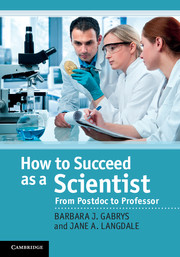Book contents
- Frontmatter
- Contents
- Preface
- Acknowledgements
- Part I Becoming an independent researcher
- Part II Thriving in your new job
- 10 Handling new roles
- 11 Learning from other people
- 12 Managing people
- 13 Building a research group I
- 14 Building a research group II
- 15 Interacting with others
- 16 Designing a taught course
- 17 Giving a good lecture
- 18 Beyond lecturing
- 19 Mentoring
- Part III Managing your career
- Index
11 - Learning from other people
from Part II - Thriving in your new job
Published online by Cambridge University Press: 05 November 2011
- Frontmatter
- Contents
- Preface
- Acknowledgements
- Part I Becoming an independent researcher
- Part II Thriving in your new job
- 10 Handling new roles
- 11 Learning from other people
- 12 Managing people
- 13 Building a research group I
- 14 Building a research group II
- 15 Interacting with others
- 16 Designing a taught course
- 17 Giving a good lecture
- 18 Beyond lecturing
- 19 Mentoring
- Part III Managing your career
- Index
Summary
You will have just made the transition from being one of the most academically able and experienced postdocs in a research group to being the most inexperienced PI in the department. Although you only really learn from your own errors, you can avoid mistakes if you know ahead of time what they are likely to be. In this chapter we asked four young PIs to recall their experiences of the postdoc–PI transition and to offer their advice for avoiding problems – the advice is remarkably consistent.
The theory
There is a constant tension between change and routine, and in the context of an academic career it is perhaps most visible during the transition from postdoc to PI. Before we turn to the practicalities of doing well during this period, it is worthwhile considering the wider background. Life is change – stars are born, live and die on such a long timescale that humans cannot even imagine, and at the other end of the scale processes in living cells occur over nanoseconds. However, as the popular saying goes, ‘only busy cashiers and wet babies like change’. Change unsettles us and our biological reaction is of the ‘fight or flight’ type. But change also brings renewal and opportunities, and in a professional environment, if it is tackled well, it can strengthen your career prospects for years to come.
As seen in Chapters 8 and 9, you can start your independent research career either in the context of an academic job or as an independent research fellow. Although the two positions carry different duties and expectations, they share one thing in common – time has to be managed differently from when you were a postdoc. While many postdocs work very hard, they often work at hours to suit themselves (certainly not 9–5). However, as a PI you have to fit in with other people – either in the context of time-tabled lectures and meetings or to oversee the work of your research group.
- Type
- Chapter
- Information
- How to Succeed as a ScientistFrom Postdoc to Professor, pp. 108 - 115Publisher: Cambridge University PressPrint publication year: 2011



